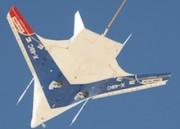 |
| Reviews and Templates for Expression We |
NASA Plane Wing Could Halve Fuel Use

A NASA research team has developed a manufacturing process for an airplane “hybrid wing” that could cut fuel consumption in half compared to traditional aircraft.
Aerospace engineers have known for a long time that an aircraft shaped somewhat like a manta-ray, blending the shape of the fuselage with the wings, would be far more efficient than traditional tubular fuselage. But up until now no one has been able to invent a manufacturing method that makes the design practical, reports MIT Technology review.
NASA’s new manufacturing process lowers the structural weight of aircraft components by 25 percent and is revolutionary because it tackle two key problems that have faced hybrid wing manufacture in the past: controlling the aircraft and maintaining a pressurized cabin.
Keeping a hybrid wing airplane under control at low speeds – a function that is essential for maneuvers including take-off and landing – has long been a challenge for aerospace engineers, but following a series of test flights with a six-meter-wide remote-controlled model (pictured) and now with a full-scale remote-controlled plane, the agency says it has solved the problem.
One reason traditional tubular fuselages have been used for planes is that the natural structural strength of a tube is very good at withstanding the forces acting on it from outside the aircraft during flight. The flatter shape of a hybrid wing, which includes some right angles, is naturally less structurally sound and much harder to build in a way that’s both strong enough and light enough to be practical, according to the review. NASA’s new method uses a combination of carbon composite rods, carbon fiber fabric and epoxy to create a rigid structure, the publication says.
To reach its lofty fuel consumption expectations, the hybrid wing would need to be combined with a hyper-efficient type of engine, called an ultra-high bypass ratio engine. It may take 20 years for the technology to come to market, but the new manufacturing method could help improve conventional commercial aircraft withing eight to 10 years.
In August last year, NASA selected a team lead by Ball Aerospace & Technologies Corporation for a demonstration of a high performance “green” alternative to the highly toxic fuel hydrazine.
|
|
|
|
Copyright 2011 Energy and Technical Services Ltd. All Rights Reserved. Energyts.com |